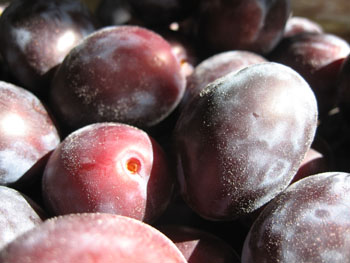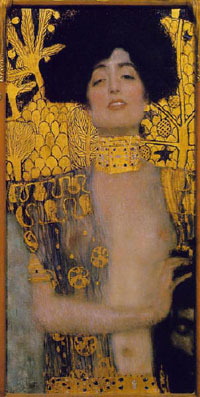Okay, so I went plum picking with friends this weekend, which was awesome. We got enough plums to completely bury someone like, say, John Travolta, in an avalanche of plumdom. Companion made jam out of most of them, like the sweet burly Martha he is. I made a tart last night, and it turned out pretty well. We also foisted many on friends and neighbors.
I was watching my friend shine one up to give to Strudel, and I thought to myself, “What the crap is that dust on the outside of the plum, anyway?” Our other friend suggested it was some kind of wax, but after some cursory wiki-ing I don’t think so now. There’s dust on grapes, too, especially concords.

What is it?
In other news, we are completely overrun by fruit flies. I think it started when we went out of town. But we have a garden spider who, as of this morning, I have named Judith due to a discussion of biblical women with my cool frond. Every time she catches a fruit fly I pretend it’s Holofernes’s head.

I was just thinking that “Jusith Holofernes” would be a great name for a character in a novel, but it looks like it’s been done. Dag. Back to the drawing boardz.
Religion: I’m in it for the art. And lulz.

Plum Dust? Looks like mildew to Bossy. But plum dust – Plum Dust is more romantic.
They put clay dust on organic fruit sometimes. It deters bad organisms.
It’s calcium hydroxide, I think. I looked up “film on fruit” and found this:
“A variety of commercial products are available to control sunburn, including calcium hydroxide (Ca (OH)2), Surround
Those are Italian prunes. They always have that dusting on them, from the time they are hard and green on the tree until they get picked and shined. It’s definitely not a manufactured coating.
Right, it’s the dust that’s on them right off the tree, which certainly was not sprayed or treated.
It’s yeast.
If you ever have the urge to make a sourdough starter, put some grapes (or plums, apparently, though I’ve never seen that in action) tucked around the dough as you let it rise for the first time. That ensures it’ll get plenty of yeast from its environment, and also imparts a nice, faintly fruity flavor to the eventual bread.
Yum o. On the bread tip, anyway. Well, thank you. I always know to ask you guys.
I recently read about putting some vinegar in a glass to catch those pesky little flies. Or maybe it was bicarb or something, maybe it was yak’s milk, something in a glass anyway… Or perhaps I’m making it up (possible)? Yoikes.
I like to lure fruitflies into a plastic sack (a longer sack, like a bread bag works best) with a piece of fruit overnight, then while they are nibbling away at breakfast, I snatch the bag closed and toss them into the outside garbage! hahaaha!!! (vacuum-gettin’-em works well, too)
That is smart. I am using a wine bottle with about an inch of apple cider vinegar.
I know that grapes have yeast on them naturally (so when you make wine at home, you don’t add any yeast or anything, you just don’t wash the grapes!)…so I would second the idea that it might be a yeasty coating.
The dust appears to be fine fibrils of cuticular wax!!
http://aob.oxfordjournals.org/cgi/content/abstract/27/4/581
WOW! Shiny. Thanks, suebob. Mah friend, he was right.
I tried the apple vinegar on our fruit flies, but they just weren’t interested. What finally worked was putting a banana peel in the bottom of a glass, setting a coffee filter with a hole in the bottom over it and sealing the edges (folding worked), and waiting overnight. Most of the flies ended up in the glass, but I couldn’t think how to get rid of them 1. humanely, and 2. without them flying right back in the window, so I poured water in the glass to drown them. Two days later, no more flies!
Good luck, because they are the most annoying things in the world.
We have fruitflies because they like the moisture in our potted herbs. And also because of the fruit we have lying around. But they mostly hang out by the plants.s
I poured some beer in a wide bowl and let it sit, and they merrily drowned themselves in the beer.
Vodka did not work, however.
Too much booze and not enough sugar, I’ll warrant. Don’t waste the good stuff on the little jerks!
What do you know? I bought a package of concord grapes this afternoon (at $3 a box, it was a steal from the fruit stand), and I didn’t notice any dust. Then again, I also ate some before I washed them, so clearly I am not a person to be trusted.
Plum dust is way better-cuticular wax sounds like some sort of excruciating nail treatment.
My favorite depiction of Judith beheading Holofernes is Artemisia Gentileschi’s:
http://www.artchive.com/artchive/G/gentileschi/gent_holofernes.jpg.html
click on ‘image viewer’ to get the full-sized blood-spurting goodness. :)
“Bloom on fruit such as plums or grapes is a white or bluish covering. Once thought to be wild yeast cells, it is now known to be waxy coverings to the epithelial cells of the fruit, presumably intended to provide some protection from environmental damage.”